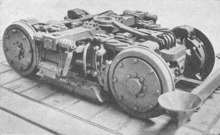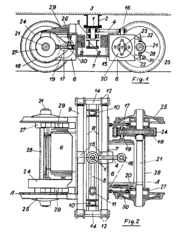Simplex bogie
The Simplex bogie was a type of motor bogie for trams and light railcars developed by BBC together with Waggonfabrik Uerdingen .
history
In the 1930s, most tram railcars were equipped with Tatzlager motors . This construction put a lot of stress on the tracks because part of the mass of the motor was unsprung on the shaft of the wheelset . In addition, the wheels of the chassis could not be designed to be arbitrarily small, because otherwise the drive motor would also have become very small in diameter and therefore would have had too little power. This led to high-lying car floors in vehicles with peg bearing motors. This was remedied by bogies with a longitudinally installed motor, the housing of which was also the supporting structure of the bogie. A first patent for such a bogie was published by Waggonfabrik Uerdingen in 1932, but with this construction the axle guides that were rigidly attached to the engine resulted in a very stiff chassis that was difficult to follow twisting in the track. The only primary suspension was the rubber-sprung wheels.
BBC improved the construction in such a way that the axles were given more freedom of movement. It was used for the first time in Switzerland in 1936 on the Ce 4/4 1 of the Biel-Meinisberg Railway and was called the Simplex bogie . The railcar was to remain the only vehicle in which design 1 was used.
Design 2 , which was first used in 1941, differed significantly from design 1 from a structural point of view, because it again used transversely installed motors. However, like design 1, it used the motor housing as the supporting structure of the bogie. This design was first in the Pedalern and Kurbeli for Urban streetcar Zurich applied from which the Swiss standard cars were derived for trams. Further applications were the bogies of the Ce 4/4 41 and 42, the United Bern – Worb-Bahnen (VBW) and the three motor cars Ce 2/4 601–603 of the Basel tram , which carried the nickname Bugatti .
technology
Design 1
Type 1 was probably only used on the Ce 4/4 1 railcar of the Biel-Meinisberg Railway. The load-bearing structure of the bogie was the longitudinally installed traction motor, to the housing of which the axle drives were flanged at the front and rear . The pivot pin was attached to the top of the drive motor housing, while the mounts for the secondary springs were screwed on to the side. The wheel sets with inner bearings were guided in parallel by axle links that were attached to the engine housing. The primary suspension of a wheel set was taken over by coil springs , which were located between a longitudinal member attached to the side of the engine and the axle links. The suspension of the other set of wheels was taken over by pairs of leaf springs also attached to the engine at the top and bottom , which were supported on the wishbone with the bearing. The wheel set with the coil springs could move around the longitudinal axis of the bogie by an angle of +/- 1 °, which the bogie could compensate for twisting in the track. So that the movements of the wheel are not transmitted to the motor shaft, the axle drive this wheel set was working on a hollow shaft , over a BBC spring drive with the axle was connected. The bogie was designed with spoked wheels without suspension in the wheel disc.
Type 2
In the more common type 2, transversely installed motors were used again. These were screwed together with a large U-profile, which formed the load-bearing structure of the bogie. The cradle of the bogie was housed in the U-profile. The two motors supported themselves with leaf spring assemblies on the axles-guided wheel sets, which also had inner bearings. The motor shafts were made hollow. At one end of the motor shaft there was a spring washer coupling, which transmitted the force to a second shaft running through the hollow shaft, which in turn transmitted the torque to a pinion at the other end with a spring washer coupling. This intervened in the large wheel mounted on the wheel set. The wheel protection box around the pinion and large wheel was mounted on the wheelset shaft and connected to the U-profile between the motors with a handlebar.
Patents
- Simplex bogie design 1: Patent CH201497 : bogie, especially on relatively light electrically operated rail vehicles. Published February 16, 1939 , inventor: BBC .
- Simplex bogie design 2: Patent CH213831 : Frameless bogie equipped with two electric drive motors, especially for rail vehicles. Published on June 16, 1941 , inventor: BBC .
Individual evidence
- ↑ Patent DE564510 : Motorized bogie , especially for trams. Published on November 19, 1932 , applicant: Waggonfabrik Uerdingen .
- ^ Karl Sachs: Electric traction vehicles. tape 1 . Springer-Verlag, 2019, ISBN 978-3-7091-4380-3 , pp. 595-560 ( google.com [accessed January 25, 2020]).
- ↑ patent CH201497
- ↑ patent CH213831



